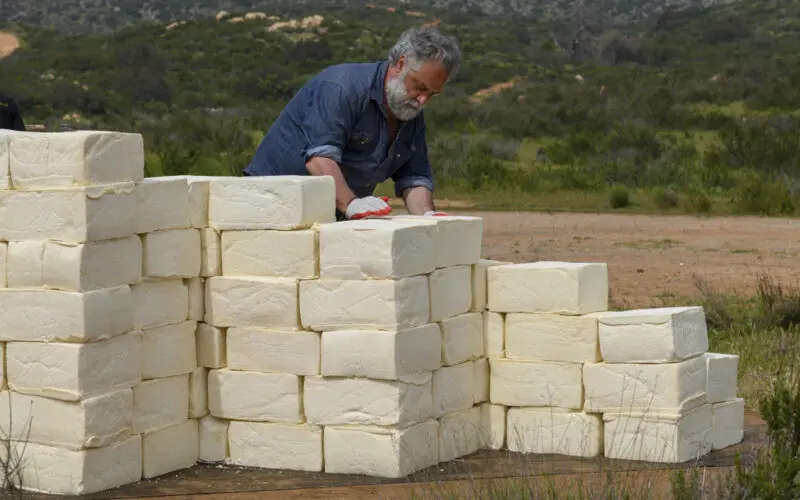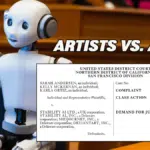Food-art specialist Cosimo Cavallaro has filed a new complaint under the Visual Artists Rights Act against federal contractors he claims intentionally destroyed his “Cheese Wall” at the U.S.-Mexico border. Does he have a case?
Like most Americans and many other democracy and/or train wreck-loving folks around the globe, I’ve been preoccupied with the U.S. presidential election for the past few days. That said, copyright news waits for no one. Case in point is a new lawsuit that, consistent with this week’s national preoccupation, is politically-adjacent. More particularly, it’s located at the lightly-traveled intersection of intellectual property and Mexican cheese.
Enter Los Angeles artist Cosimo Cavallaro, who specializes in “perishable” art. Cavallero’s work runs the gamut from “Ham Bed” (a bed topped with a super-sized order of cured meats) to “Sweet Jesus” (a sculpture of a naked Jesus Christ, in the crucifixion pose, made entirely of chocolate).
The Cheese Wall
But it’s Cavallaro’s giant wall made of cheese—thoughtfully placed right alongside the U.S.-Mexico border—that’s the star of a new lawsuit (read here) filed in federal court in the Southern District of California.
While all of us have certainly dreamed from time to time about building a giant cheese wall, Cavallaro actually turned that dream into a reality—or at least he started to. Cavallaro’s plan was to build his own 1,000-foot “border wall” entirely out of blocks of Cotija cheese. A non-profit organization, Art Above Ground, leased private land for the project, and launched a campaign to raise money for supplies and labor to build the wall. (You didn’t think Mexico was going to pay for it did you?)
In March 2019, Cavallaro began the cheese wall construction process. He made the cheese himself, formed the bricks, salted and drained them of water and configured them in the shape of a wall. Each block weighed over fifty pounds.

And lest you were wondering, yes, there was a message behind all this cheese. Cavallaro wanted people to think differently about Donald Trump’s ambitious border wall project “by considering the ephemerality of walls and the waste inherent in building any wall, whether made of cheese or steel. ”
Cavarallo’s Lawsuit
According to the new lawsuit filed by Cavallaro and Art Above Ground, his cheese wall ended up being too ephemeral, as a result of conduct undertaken by defendants SLSCO and Ultimate Concrete. These private companies, hired to fortify the actual (non-cheese) border wall between the U.S. and Mexico, are accused of using heavy machinery to bury the Cheese Wall, destroying it beyond repair.
As a result, Cavallaro claims that he “has been deprived of the opportunity to communicate his artistic message through the Cheese Wall—a message he has spent years contemplating—and to see the Cheese Wall, at its full length, stand in contrast to the border wall.”
In addition to more “garden variety” causes of action like conversion, nuisance and trespass, Cavallaro is seeking relief pursuant the U.S. Copyright Act. In particular, he’s suing for infringement under the Visual Artists Rights Act (VARA), which was the first U.S. federal copyright legislation to grant protection for “moral rights.”
Moral Rights
The term “moral rights” is a translation of the French term droit moral. It generally refers to an artist’s right to control the reputational fate of his or her copyrighted works, even if economic rights in those works have already been sold.
Moral rights are fairly well-established in European civil law countries like France and Germany. Depending upon the particular law involved, artists may have the right to receive or decline credit for their works, to dictate how their works are displayed, and even to prevent their works from being altered or destroyed without permission.
For example, in the 1990’s, the highest court in France held that Ted Turner’s colorization of the John Huston Film “The Asphalt Jungle,” which was originally shot in black and white, violated the director’s moral rights as protected by French law. Even though Turner had legally acquired the copyright in the film, broadcasting a colorized version of Huston’s work improperly altered the director’s aesthetic choices. Indeed, moral rights are so well-defined in France that most films broadcast on French television are shown without commercials, so as not to affect the director’s original vision.
The Visual Artists Rights Act (VARA)
The result in the Huston case would have been different under United States law, which is much more comfortable with the concepts of “ownership” and economic rights than it is with protecting an artist’s reputation and the integrity of creative works.
That said, we do recognize moral rights in certain limited situations here in the U.S., most notably in VARA. Codified in section 106A of the Copyright Act, VARA applies exclusively to works of visual art.
Among the rights granted to authors of qualifying works under VARA are: (i) the right to claim authorship, (ii) the right to prevent the use of one’s name on any work the author did not create, (iii) the right to prevent use of one’s name on any work that has been distorted, mutilated, or modified in a way that would be prejudicial to the author’s honor or reputation, and (iv) the right to prevent distortion, mutilation, or modification that would prejudice the author’s honor or reputation.
In addition, authors of works of “recognized stature” may prohibit intentional or grossly negligent destruction of their works. This right, set forth in Copyright Act section 106A(a)(3)(B), is what’s at issue in Cavallaro’s lawsuit.
Does Cavallaro Have a Case?
There are a few potentially disputed issues that may come into play as Cavarallo’s lawsuit proceeds through the court.
Works of Visual Art
First, is a Cheese Wall a work of visual art? Well, sculptures certainly qualify as works of visual art, and there’s nothing stopping artists from using meat, chocolate or cheese as a medium. But what about a wall, which under normal circumstances would be a “useful article” that isn’t in and of itself subject to copyright protection? Putting aside the debate of how effective the actual border wall is as a deterrent device, cheese would be presumably even less effective. By all accounts Cavarallo’s Cheese Wall was not designed to actually keep anyone out or inside, and was intended to be solely a work of artistic expression.
Recognized Stature
Second, is the Cheese Wall a work of recognized stature? This requirement is what prevents your children from filing suit under VARA if you trash one of their school art projects.
VARA doesn’t define a “work of recognized stature,” leaving it for courts to develop the concept as cases arise under the law. We’ve seen in practice that art certainly doesn’t need to be “traditional” in order to qualify for protection against destruction. Earlier this year, the Second Circuit affirmed a whopping $6.75 million judgment in a landmark VARA case against a real estate developer who willfully whitewashed 45 works of graffiti art at the 5Pointz property in Queens.

In attempting to prove that his Cheese Wall was a work of “recognized stature,” Cavallaro’s lawyers will likely point to his prior works and reputation as an artist, as well as the media attention that his wall received before it was destroyed. Expect the defendants’ lawyers to counter that the coverage afforded the work owed more to its status as a curiosity than its artistic stature. Ultimately, this issue may need to be decided via testimony by art experts or members of the artistic community.
The defendants in Cavallaro’s case may also assert that the work can’t be of recognized stature because of its temporal nature. Putting aside the that the installation was prematurely destroyed, the fact is that walls of cheese won’t stand the test of time even if they aren’t bulldozed. This was the whole point—Cavallaro wanted to comment on the ephemeral nature of walls in general. Indeed, at the time he started construction, Cavallaro admitted that the wall might fall apart or be eaten by animals before it could be finished.
However, a similar argument was rejected in the 5Pointz case. Although the graffiti art at issue there was “temporary,” because all parties knew that at some point in the not-so-distant future 5Pointz would be demolished, the works could still gain recognized stature. Similar argument by the defendants in Cavallaro’s case probably won’t find much success either.
The fact that Cavallaro’s work was unfinished may also come into play when assessing its stature, although other courts in similar cases have found that a work of art can be of recognized stature even if it’s incomplete.
Intentional or Grossly Negligent Destruction
The final issue I’ll highlight is VARA’s requirement that Cavallaro prove that his Cheese Wall was destroyed as a result of intentional or grossly negligent acts by the defendants. The complaint offers a theory of his case in this regard: Among the contributors to Cavarallo’s fundraising efforts for the Cheese Wall was Israel Evans, an employee of Ultimate Concrete. Cavallaro will use this fact to show that the defendants were aware that the wall was a work of art. The complaint also alleges that Evans contacted Cavallaro in October 2019, asking whether he wanted SLSCO to remove the then-unfinished Cheese Wall. Cavallaro claims he said no, but that when he returned to the site the following month, he found that the art installation had been destroyed by heavy machinery. The artist’s counsel will use this evidence to argue that the destruction of the Cheese Wall was intentional or, at the very least, grossly negligent.

More to come on this cheesy case as it develops.
Meanwhile, I’m happy to report that after less than 3 months in existence, Feedspot has named Copyright Lately as one of the Top 50 Copyright Blogs on the internet. That said, we came in well behind sites that haven’t been updated since 2013, so I’m not sure what exactly to make of the recognition. Comments, as always, are encouraged.







1 comment
Simply wanna tell that this is very useful , Thanks for taking your time to write this. Muire Claudio Kahler